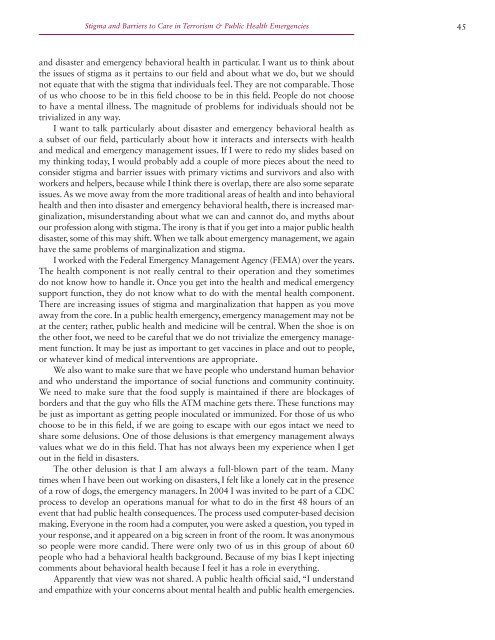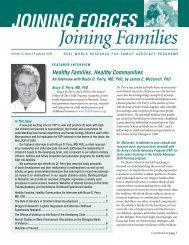stigma and barriers to care - Uniformed Services University of the ...
stigma and barriers to care - Uniformed Services University of the ...
stigma and barriers to care - Uniformed Services University of the ...
Create successful ePaper yourself
Turn your PDF publications into a flip-book with our unique Google optimized e-Paper software.
Stigma <strong>and</strong> Barriers <strong>to</strong> Care in Terrorism & Public Health Emergencies 45<br />
<strong>and</strong> disaster <strong>and</strong> emergency behavioral health in particular. I want us <strong>to</strong> think about<br />
<strong>the</strong> issues <strong>of</strong> <strong>stigma</strong> as it pertains <strong>to</strong> our field <strong>and</strong> about what we do, but we should<br />
not equate that with <strong>the</strong> <strong>stigma</strong> that individuals feel. They are not comparable. Those<br />
<strong>of</strong> us who choose <strong>to</strong> be in this field choose <strong>to</strong> be in this field. People do not choose<br />
<strong>to</strong> have a mental illness. The magnitude <strong>of</strong> problems for individuals should not be<br />
trivialized in any way.<br />
I want <strong>to</strong> talk particularly about disaster <strong>and</strong> emergency behavioral health as<br />
a subset <strong>of</strong> our field, particularly about how it interacts <strong>and</strong> intersects with health<br />
<strong>and</strong> medical <strong>and</strong> emergency management issues. If I were <strong>to</strong> redo my slides based on<br />
my thinking <strong>to</strong>day, I would probably add a couple <strong>of</strong> more pieces about <strong>the</strong> need <strong>to</strong><br />
consider <strong>stigma</strong> <strong>and</strong> barrier issues with primary victims <strong>and</strong> survivors <strong>and</strong> also with<br />
workers <strong>and</strong> helpers, because while I think <strong>the</strong>re is overlap, <strong>the</strong>re are also some separate<br />
issues. As we move away from <strong>the</strong> more traditional areas <strong>of</strong> health <strong>and</strong> in<strong>to</strong> behavioral<br />
health <strong>and</strong> <strong>the</strong>n in<strong>to</strong> disaster <strong>and</strong> emergency behavioral health, <strong>the</strong>re is increased marginalization,<br />
misunderst<strong>and</strong>ing about what we can <strong>and</strong> cannot do, <strong>and</strong> myths about<br />
our pr<strong>of</strong>ession along with <strong>stigma</strong>. The irony is that if you get in<strong>to</strong> a major public health<br />
disaster, some <strong>of</strong> this may shift. When we talk about emergency management, we again<br />
have <strong>the</strong> same problems <strong>of</strong> marginalization <strong>and</strong> <strong>stigma</strong>.<br />
I worked with <strong>the</strong> Federal Emergency Management Agency (FEMA) over <strong>the</strong> years.<br />
The health component is not really central <strong>to</strong> <strong>the</strong>ir operation <strong>and</strong> <strong>the</strong>y sometimes<br />
do not know how <strong>to</strong> h<strong>and</strong>le it. Once you get in<strong>to</strong> <strong>the</strong> health <strong>and</strong> medical emergency<br />
support function, <strong>the</strong>y do not know what <strong>to</strong> do with <strong>the</strong> mental health component.<br />
There are increasing issues <strong>of</strong> <strong>stigma</strong> <strong>and</strong> marginalization that happen as you move<br />
away from <strong>the</strong> core. In a public health emergency, emergency management may not be<br />
at <strong>the</strong> center; ra<strong>the</strong>r, public health <strong>and</strong> medicine will be central. When <strong>the</strong> shoe is on<br />
<strong>the</strong> o<strong>the</strong>r foot, we need <strong>to</strong> be <strong>care</strong>ful that we do not trivialize <strong>the</strong> emergency management<br />
function. It may be just as important <strong>to</strong> get vaccines in place <strong>and</strong> out <strong>to</strong> people,<br />
or whatever kind <strong>of</strong> medical interventions are appropriate.<br />
We also want <strong>to</strong> make sure that we have people who underst<strong>and</strong> human behavior<br />
<strong>and</strong> who underst<strong>and</strong> <strong>the</strong> importance <strong>of</strong> social functions <strong>and</strong> community continuity.<br />
We need <strong>to</strong> make sure that <strong>the</strong> food supply is maintained if <strong>the</strong>re are blockages <strong>of</strong><br />
borders <strong>and</strong> that <strong>the</strong> guy who fills <strong>the</strong> ATM machine gets <strong>the</strong>re. These functions may<br />
be just as important as getting people inoculated or immunized. For those <strong>of</strong> us who<br />
choose <strong>to</strong> be in this field, if we are going <strong>to</strong> escape with our egos intact we need <strong>to</strong><br />
share some delusions. One <strong>of</strong> those delusions is that emergency management always<br />
values what we do in this field. That has not always been my experience when I get<br />
out in <strong>the</strong> field in disasters.<br />
The o<strong>the</strong>r delusion is that I am always a full-blown part <strong>of</strong> <strong>the</strong> team. Many<br />
times when I have been out working on disasters, I felt like a lonely cat in <strong>the</strong> presence<br />
<strong>of</strong> a row <strong>of</strong> dogs, <strong>the</strong> emergency managers. In 2004 I was invited <strong>to</strong> be part <strong>of</strong> a CDC<br />
process <strong>to</strong> develop an operations manual for what <strong>to</strong> do in <strong>the</strong> first 48 hours <strong>of</strong> an<br />
event that had public health consequences. The process used computer-based decision<br />
making. Everyone in <strong>the</strong> room had a computer, you were asked a question, you typed in<br />
your response, <strong>and</strong> it appeared on a big screen in front <strong>of</strong> <strong>the</strong> room. It was anonymous<br />
so people were more c<strong>and</strong>id. There were only two <strong>of</strong> us in this group <strong>of</strong> about 60<br />
people who had a behavioral health background. Because <strong>of</strong> my bias I kept injecting<br />
comments about behavioral health because I feel it has a role in everything.<br />
Apparently that view was not shared. A public health <strong>of</strong>ficial said, “I underst<strong>and</strong><br />
<strong>and</strong> empathize with your concerns about mental health <strong>and</strong> public health emergencies.




